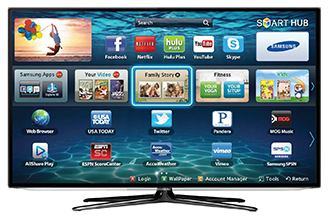Smart TV Still the Wild West?
By Paul Gagnon
 The first Smart TVs shipped more than three years ago, and have been an area of intense focus by many of the TV industry leaders, highlighting CES booths alongside other developments such as 3D and 4K. But with all the time that has passed, there has not been a significant amount of consolidation around successful platforms, such as has happened in the mobile segments. Why not? Why do Smart TV companies insist so often on blazing their own path to the exclusion of industry progression and potentially better consumer adoption? This isn’t much changed from the early Wild West days of the Smart TV category.
The first Smart TVs shipped more than three years ago, and have been an area of intense focus by many of the TV industry leaders, highlighting CES booths alongside other developments such as 3D and 4K. But with all the time that has passed, there has not been a significant amount of consolidation around successful platforms, such as has happened in the mobile segments. Why not? Why do Smart TV companies insist so often on blazing their own path to the exclusion of industry progression and potentially better consumer adoption? This isn’t much changed from the early Wild West days of the Smart TV category.
I think the answer is simple: Brands still believe there is significant money to be made by attracting consumers to their protected platform.
However, there is little evidence of manufacturers finding success in such efforts, and the development effort and cost to continue with your own platform do not seem to pay off. At the same time, potential open-source efforts like Google TV and the Smart TV Alliance seem to have fizzled while Samsung and LGE announced complete new software environments for their Smart TVs at CES. DisplaySearch’s own consumer research suggests that people just want to use a lean-back device like the TV for a select few low-involvement activities, so complexity and proprietary applications seem unnecessary. With streaming one of the first significant sources of 4K content becoming a reality this year, perhaps there is a new opportunity to reignite interest in Smart TVs.
The success of other streaming devices connected to the TV also brings into question the value of integrating the function within the TV. It’s fairly easy for a consumer to take a 2 year old HD flat panel TV, and make it a Smart TV with the addition of a streaming set-top-box, Blu-Ray player or gaming console. Often, the cost of these solutions is less than the premium for a Smart TV over a basic set. Admittedly, it’s not an elegant wire-free solution, but over 90% of US TV households have put up with a pay-TV box for decades without significant complaint. Globally, the connected TV share of shipments has only improved from 30% in 2012 to 34% in 2013 according to the latest DisplaySearch Quarterly Advanced TV Design and Features Report, mostly as emerging markets fail to take up the technology. Developed Smart TV markets such as Japan and Europe have plateaued in recent quarters, but the US has seen stronger gains recently as the premium has dropped to more mainstream price points.
What does the future hold for Smart TV – more fragmentation or the development of true ecosystems? This and other topics will be explored at the upcoming US FPD Connected Devices conference with companies like Roku, TiVo, Samsung and SambaTV.
This column was reprinted with permission from DisplaySearch and originally appeared here.





